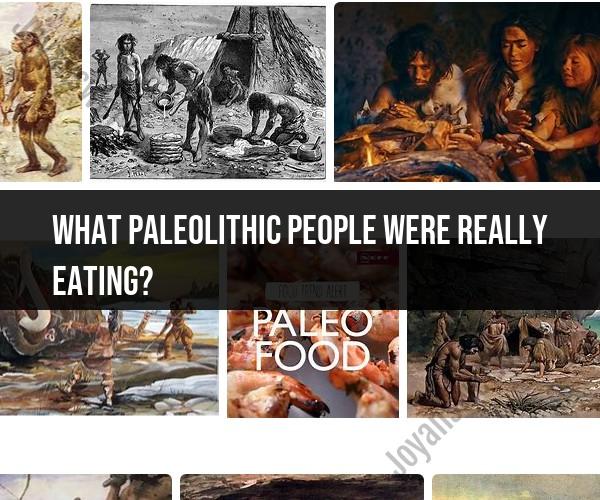What Paleolithic people were really eating?
The Paleolithic diet, often referred to as the "Paleo diet" or "caveman diet," is a modern dietary trend that attempts to mimic the eating habits of our Paleolithic ancestors, who lived from about 2.6 million years ago to around 10,000 years ago. However, it's important to note that our understanding of the Paleolithic diet is based on archaeological and anthropological evidence, and there is some debate and speculation about the exact dietary habits of Paleolithic people. Here's what is generally believed about what Paleolithic people were really eating:
Wild Game: Paleolithic people were likely hunters and gatherers, and a significant portion of their diet would have consisted of wild game. This included animals like deer, bison, mammoths, and smaller game animals. They would have used tools and weapons to hunt and kill these animals.
Fish and Seafood: Depending on their geographic location, some Paleolithic populations had access to rivers, lakes, and oceans, and would have included fish and seafood in their diet. Shellfish, in particular, might have been a significant food source in coastal regions.
Plant Foods: Paleolithic people gathered a wide variety of plant foods, including fruits, vegetables, nuts, seeds, roots, and tubers. These foods were seasonally available and would have provided essential nutrients.
Insects and Small Animals: Insects, such as ants, grubs, and termites, were likely part of the diet, especially during times when other food sources were scarce. Small animals like birds and rodents may also have been consumed.
Honey: Paleolithic people would have collected honey from wild beehives when available. Honey provided a source of natural sweetness and energy.
No Grains or Dairy: The Paleolithic diet typically excludes grains (such as wheat, rice, and oats) and dairy products (milk, cheese, and yogurt) because it's believed that these foods were not part of the Paleolithic diet due to the lack of agriculture and domesticated animals during that time.
Limited Processing: The Paleolithic diet emphasizes whole, unprocessed foods. Paleolithic people did not have access to modern food processing techniques, so their food would have been consumed in its natural state or minimally processed.
Regional Variation: It's important to recognize that the Paleolithic diet varied depending on geographic location, climate, and the availability of resources. People in different regions would have had different foods in their diets.
No Modern Additives: The Paleolithic diet excludes modern food additives, preservatives, and processed sugars, which were not part of the Paleolithic era.
While the Paleolithic diet is often touted as a way to promote health and reduce modern health problems, it's essential to approach it with a critical eye. Our understanding of the Paleolithic diet is based on educated guesses and extrapolation from archaeological evidence, and it may not fully capture the dietary diversity of ancient humans. Additionally, modern foods and lifestyles have evolved significantly, making it challenging to directly replicate the diets of our Paleolithic ancestors. Therefore, individuals interested in adopting a Paleo-style diet should do so with a focus on whole, unprocessed foods and consult with healthcare professionals or nutritionists for personalized guidance.
Unraveling the Diet of Paleolithic People
Paleolithic people, also known as hunter-gatherers, lived during the Paleolithic Era, which lasted from over 2 million years ago to about 12,000 years ago. During this time, humans had not yet developed agriculture, so their diet was based on the foods that they could hunt and gather.
What did Paleolithic people really eat? Researchers have studied the fossilized remains of Paleolithic people, their tools, and their environment to reconstruct their diet. They have found that Paleolithic people ate a wide variety of foods, including:
- Meat: Meat was a major part of the Paleolithic diet. Paleolithic people hunted a variety of animals, including bison, deer, rabbits, and birds.
- Fish: Fish was also an important part of the Paleolithic diet, especially for people who lived near the coast.
- Fruits and vegetables: Paleolithic people gathered a wide variety of fruits and vegetables, including berries, nuts, roots, and leaves.
- Eggs: Paleolithic people gathered eggs from wild birds.
Paleolithic people did not eat grains, legumes, or dairy products. These foods were not yet domesticated, and they would have been difficult for Paleolithic people to obtain.
What Did Our Ancestors Really Eat in the Paleolithic Era?
Paleolithic people ate a diet that was high in protein and fat, and low in carbohydrates. This diet is similar to the modern-day Paleo diet.
The Paleo diet is a popular diet that is based on the foods that are thought to have been eaten by Paleolithic people. The Paleo diet excludes grains, legumes, dairy products, and processed foods. Instead, the Paleo diet focuses on meat, fish, fruits, vegetables, nuts, and seeds.
Understanding the Prehistoric Paleolithic Diet
The Paleolithic diet was a healthy diet. Paleolithic people had a low rate of obesity, heart disease, and other chronic diseases.
However, the Paleolithic diet is not without its critics. Some critics argue that the Paleo diet is too restrictive and that it is not practical for modern people to follow. Others argue that the Paleo diet is not based on solid scientific evidence.
Despite the criticism, the Paleo diet remains a popular diet. Many people believe that the Paleo diet is a healthy way to eat and that it can help them to lose weight and improve their health.
If you are considering following the Paleo diet, it is important to talk to your doctor or a registered dietitian to make sure that it is right for you.













